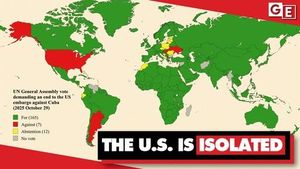On the heels of a turbulent economic year, the U.S. Federal Reserve’s latest move to lower its key interest rate by a quarter of a percentage point has ignited a heated debate among policymakers, economists, and everyday Americans. While the central bank’s decision on October 30, 2025, marks a modest shift, the question of what comes next has gripped financial markets and Main Street alike. Treasury Secretary Scott Bessent, speaking on CNN’s State of the Union just days after the Fed’s announcement, urged the central bank to accelerate the pace of rate cuts, arguing that inflation is easing and certain sectors—most notably housing—are already in recession.
Bessent’s plea reflects a growing chorus of concern from both the administration and financial experts. "High mortgage rates have effectively frozen home sales, making it difficult for first-time buyers to afford homes," Bessent explained, underscoring how the housing market has taken the hardest hit from the Fed’s prolonged campaign of high interest rates. According to data from the National Association of Realtors, pending home sales were flat in September 2025, a telling sign that the market is struggling to regain its footing.
Indeed, the pain in housing is rippling outward. Bessent warned that if rates remain elevated, the damage could easily spill over into construction, retail, and other job-rich industries directly tied to real estate. "The Federal Reserve’s policies have created significant distributional problems," he said, adding that low-income households are suffering the most because they tend to have debts rather than assets. The message is clear: while the broader economy may appear solid on the surface, certain pillars are buckling under the strain of expensive borrowing costs.
Bond markets seem to agree with Bessent’s assessment. Yields on two-year Treasuries have dipped below the Fed’s benchmark rate—a classic signal that investors expect rate cuts soon. According to the CME FedWatch Tool’s futures pricing, traders now see a 70% chance of a rate cut by early 2026, up sharply from 45% just a month ago. The bond market’s message? Inflation is cooling, and the time for looser monetary policy may have arrived.
The data appears to support this view. Government figures show that consumer prices rose by about 3% year-over-year in September 2025, the slowest pace in more than two years and only one percentage point above the Fed’s 2% target. Energy and food prices, which had been major contributors to inflation’s surge, have stabilized. Core inflation—the measure that strips out those volatile items—continues to cool as well. Bessent put it bluntly: "Prices have already turned a corner, and keeping interest rates high is now doing more harm than good."
He also pointed to improvements in fiscal management as a reason for the Fed to act. The U.S. GDP deficit has shrunk from 6.4% to 5.9% thanks to spending cuts by the Trump administration, which Bessent argued reduces inflationary pressures and makes room for a looser monetary stance. "The government is consuming less through borrowing. This reduces the pressure on prices and makes more room for a looser monetary stance," he told CNN.
Despite these calls for action, the Federal Reserve’s leadership is treading carefully. Fed Chair Jerome Powell, speaking after the October rate cut, cautioned that another reduction in December is not a foregone conclusion. "A further reduction in the policy rate at the December meeting is not a foregone conclusion. Far from it," Powell said, noting the challenge of making informed decisions amid an economic data blackout caused by the government shutdown. This uncertainty has left markets on edge, with bond prices falling in the days following Powell’s press conference.
Still, some officials within the Fed are pushing for a more aggressive approach. Fed Governor Christopher Waller has publicly supported a rate cut at the December meeting, citing labor market concerns. "The biggest concern we have right now is the labor market," Waller told Fox Business Network’s Larry Kudlow. "We know inflation is going to come back down, so this is why I’m still advocating that we cut policy rates in December, because that’s what all the data is telling me to do." Waller’s stance is echoed by other officials who had advocated for a 50-basis-point cut rather than the smaller 25-point reduction ultimately approved.
Market experts are also weighing in with their forecasts. According to Reuters, four financial analysts expect interest rates to continue dropping over the next six to twelve months, with some predicting up to four more cuts by the end of 2026. Stephen Kates, a certified financial planner at Bankrate.com, noted, "When Powell speaks in a press conference, the market habitually reacts negatively for a day or two," but he expects the downward trend in rates to persist. Doug Boneparth, president of Bone Fide Wealth, added that while bond prices have fallen due to uncertainty over future cuts, fixed income remains a "decent income driver" for long-term investors because yields move in the opposite direction of prices.
The effects of the Fed’s actions are already being felt in consumers’ wallets. Rates on high-yield savings accounts are still hovering around 4%, outpacing inflation by about a percentage point. For credit card users, the most recent rate cut will save roughly $1.92 billion in interest over the next year, according to WalletHub data. And while new credit card offers remain expensive—averaging 24.19%, down from 24.92% at the start of the year—analysts like Matt Schulz of LendingTree believe rates will continue to fall between now and year’s end, regardless of what the Fed does in December.
Mortgage rates, closely tied to the 10-year U.S. Treasury note, have dropped by nearly three-quarters of a percentage point this year. The average rate on a 30-year fixed mortgage recently fell to 6.26%, well below the 7.19% high reached in mid-January, according to Bankrate. Kates predicts that within the next 12 months, mortgage rates could dip below 6%—a welcome prospect for would-be homebuyers. Home equity lines of credit and adjustable-rate mortgages, which carry variable rates, are also expected to adjust downward within two billing cycles of a Fed cut.
Yet challenges remain. Credit scores are falling nationwide as card balances rise and missed payments increase. For those carrying a balance, experts recommend exploring zero-interest balance transfer offers or negotiating better terms with card issuers. Improving one’s credit score from 600 to 700, Bankrate’s Kates noted, can significantly reduce borrowing costs.
As the debate rages on, the stakes couldn’t be higher. If the Fed delays further rate cuts, economists warn, it could worsen downturns in the housing sector and impede job growth in industries that rely on affordable credit. Conversely, moving too quickly risks reigniting inflation. With policymakers, markets, and households all watching closely, the Fed’s next steps will shape the economic landscape for months to come.
For now, the U.S. stands at a crossroads, with the path forward uncertain but the need for decisive action growing ever clearer.




